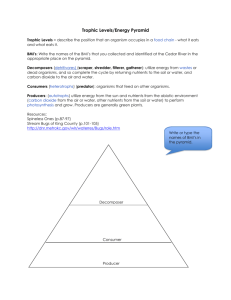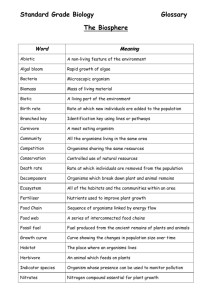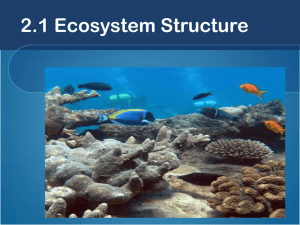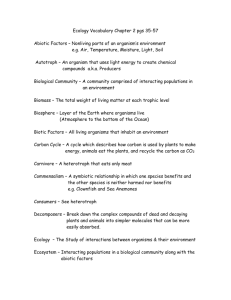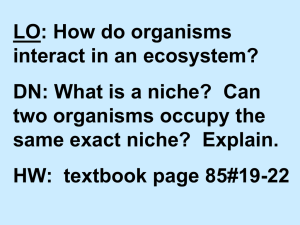2.1_Ecosystems
advertisement
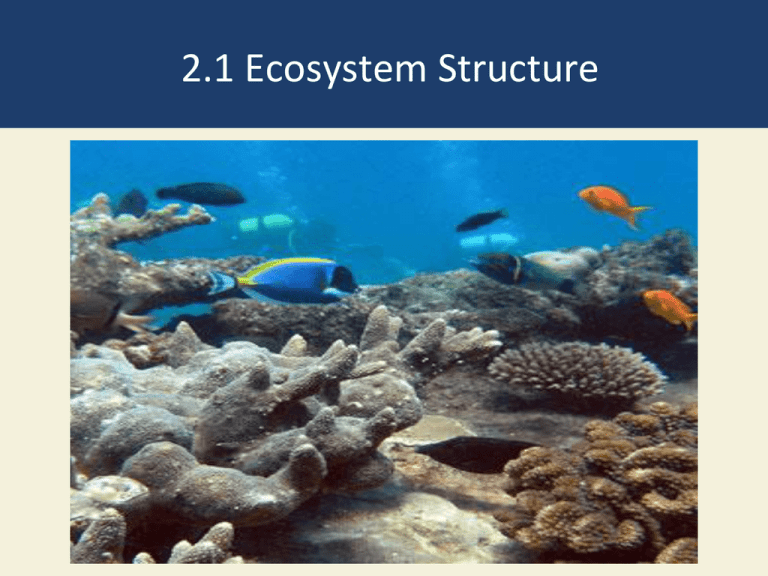
2.1 Ecosystem Structure Ecosystems Have Living and Nonliving Components • Abiotic – Non-living • • • • • • Water Air Nutrients Rocks Heat Solar energy • Biotic- Living • Any living or once living Major Biotic and Abiotic Components of an Ecosystem Fig. 3-6, p. 59 Ecologists Study Interactions in Nature • Ecology: Study of how organisms interact with each other and their environment • Species- A particular type of organism • Populations- A group of individuals of the same species living in the same place • Communities-Populations of different species living in the same place, and potentially interacting with each other • Ecosystems-A community of different species interacting with one another and with their nonliving environment of matter and energy • Habitat-An environment where a species lives • Niche- How an organism makes a living (role/job) Biosphere Parts of the earth's air, water, and soil where life is found Ecosystem A community of different species interacting with one another and with their nonliving environment of matter and energy Community Populations of different species living in a particular place, and potentially interacting with each other Population A group of individuals of the same species living in a particular place Organism An individual living being Cell The fundamental structural and functional unit of life Molecule Chemical combination of two or more atoms of the same or different elements Atom Smallest unit of a chemical element that exhibits its chemical properties Water Hydrogen Oxygen Stepped Art Fig. 3-5, p. 58 Food Chain vs. Food Web • Food Chain – shows flow of energy from one organism to another Food Chain vs. Food Web • Food web- shows flow of energy interconnected to many organisms (all possible food chains) Lake Michigan Food Web Trophic Levels • Trophic Level = feeding level (position of an organism on a food chain) Producers and Consumers • Producers- (autotrophs “self-feeders”)--Plants • Perform Photosynthesis: • Use sun energy to make their own food • Waste product is oxygen • Consumers- (heterotrophs “other feeders”) – Organisms that obtain nutrients from living things • Primary consumers = Herbivore (eats plants) • Secondary consumers – omnivores (eats both plants and animals) primary consumers and producers • Tertiary consumers- Carnivores(eat meat) other consumers Producers Fig. 3-7a, p. 59 Consumers Fig. 3-8a, p. 60 Producers and Consumers Are the Living Components of Ecosystems (2) • Decomposers • Consumers that release nutrients • Ex. Bacteria, Fungi • Detritivores (scavenger) • Feed on dead bodies of other organisms • Ex. Earthworms, Vultures Decomposer Fig. 3-9a, p. 61 Detritivores and Decomposers Fig. 3-10, p. 61 2.1.4 Ecological Pyramids • Pyramids show differences that exist between trophic levels • Always a decrease of energy and biomass when moving up a pyramid • Only ~10% of the energy from the one level is passed to the next level • ~90% of energy is used released as heat (respiration) • Three types of pyramids (biomass, numbers, energy) Pyramid of Biomass • Biomass (g m -2) • Dry weight of all organic matter of a given trophic level in a food chain or food web Pyramid of Energy • Pyramid of energy flow (J m-2 yr-1) • Less chemical energy for higher trophic levels Pyramid of Numbers • Pyramid of numbers • Shows the total number of organisms at each trophic level • Snapshot in time Pyramid structure • Bioaccumulation- concentration of toxins increases in an individual organism’s tissues • Biomagnification- concentration of toxins increases as the trophic level increases Biomagnification of DDT What is DDT? • Dichlorodiphenyltrichloroethane…that’s why we call it DDT!! • Insecticide used to fight malaria • Started in 1948 to kill mosquitoes and fight spread of malaria • Stored in the fats of organisms, and biomagnifies through the food chain • Predatory bird populations suffered • Banned in the US in 1972 2.1.7 Population Interactions Competition (- / -) • Competition – Two or more organisms in the same community seek the same resource at the same time. • Two types • Interspecific – between two different species • Intraspecific- within an individual species • Resources must be in limited supply (food, water, light, shelter, space, mates) • Mountain goat competition for mates Inter or intra??? Predation ( + / -) • Predation- One species killing another and consuming it in the process • Lions prey on wildebeests in Africa Herbivory (+/-) • Herbivory- consumption (grazing) of producers by primary consumers • Caterpillar eating leaf Parasitism (+/-) • Parasitism – Organism that lives on or in another host organism • Parasite benefits and host is harmed • Tapeworm in human intestine Mutualism (+/+) • • • • Mutualism- both organisms benefit from interactions Best example is Lichen Lichen is algae and a fungus Fungus provides structure and algae provides food source Commensalism (+ / 0) • Commensalism – One organism benefits and the other organism is not affected • Clownfish and the sea anemone Ammensalism (- / 0 ) • One species is harmed and another species is not affected. • Ex. Algae blooms can lead to the death of many species of fish, however the algae do not benefit from the deaths of these individuals. Neutralism (0 / 0) • Two organisms do not affect each other • Essentially they have no relationship • Dandelions and salmon in a ecosystem (have little or no effect on each other Big Ideas 1. Some organisms produce the nutrients they need, others survive by consuming other organisms, and some recycle nutrients back to producer organisms. 2. Human activities are altering the flow of energy through food chains and webs and the cycling of nutrients within ecosystems and the biosphere.

